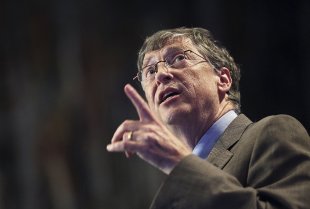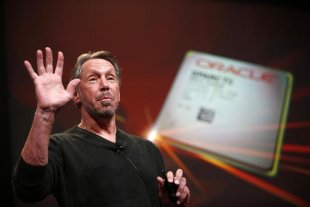[More from Forbes: Meet The 20 Newcomers To The Forbes 400]
The 400 wealthiest Americans are worth a record $2.02 trillion, roughly equivalent to the GDP of Russia. That is a gain of $300 billion from a year ago, and more than double a decade ago. The average net worth of list members is a staggering $5 billion, $800 million more than a year ago. The minimum net worth needed to make the 400 list was $1.3 billion. The last time it was that high was in 2007 and 2008, just before the financial crisis. Because the bar is so high, 61 American billionaires didn’t make the cut.
There are 20 newcomers to the list. Among the notables are Michael Rubin, whose online sports merchandise retailer Fanatics, recently attracted venture capital investors at a sky-high valuation; Jeff Sutton, who owns a number of the priciest store fronts on Fifth Avenue and Times Square, and 35-year-old Robert Pera, one of just nine under 40, whose wireless networking gear maker Ubiquiti Networks surged after a strong earnings announcement in August. At the time he tweeted this lyric from a Jay-Z song: “And as for the critics, tell me I don't get it. Everybody can tell you how to do it, they never did it.”
Only 30 people from last year’s list are poorer than a year ago. Twenty-nine people dropped out of the ranks and four people died. Of those 29, only 15 saw their fortunes drop, including T. Boone Pickens, whose costly bets on wind energy lost him his billionaire status, and Manoj Bhargava, whose 5-Hour Energy drink firm has been hit by lawsuits and falling revenues. The rest simply couldn’t keep up with the rising tide. Washington Redskins owner Dan Snyder is one of the billionaires who didn’t qualify and, in his case, even with a rise in his fortune, just didn’t have enough to stay in the club.
[More from Forbes: Falling Fortunes: The Ones That Dropped Off The Forbes 400]
The ranks are a snapshot of wealth taken on August 23, the day we locked in stock prices.
1. Bill Gates
$72 billion Up
Source: Microsoft, investments
Age: 57
Residence: Medina, Wash.
Self-made
Gates remains atop The Forbes 400, a perch he’s held since 1994, despite giving
away $28 billion, most of it to the Bill & Melinda Gates Foundation. He’s also again the world’s richest person, having reclaimed that title from Mexico’s Carlos Slim earlier this year. He bolstered his foundation’s efforts to eradicate polio in April, securing $335 million in pledges from six billionaire comrades, including $100 million each from Slim and Mike Bloomberg. Shares of Microsoft jumped in late August on news that Steve Ballmer will step down as CEO, but Gates will remain chairman of the software company he cofounded in 1975 with Paul Allen. Microsoft represents less than a fifth of his fortune. Gates’ investment firm, Cascade, owns chunks of tractormaker Deere & Co., Canadian National Railway and Mexican Coke bottler Femsa.
2. Warren Buffett
$58.5 billion Up
Source: Berkshire Hathaway
Age: 83
Residence: Omaha
Self-made
Neither age nor prostate cancer slows Buffett down: a year after completing radiation treatment, he is still doing huge deals. His Berkshire Hathaway picked up iconic ketchupmaker H.J. Heinz for $23.2 billion in June in a deal with Brazilian billionaire Jorge Paulo Lemann. A Berkshire subsidiary is buying Nevada’s NV Energy for $5.6 billion in cash. He gave away another $2 billion of Berkshire stock to the Gates Foundation in July, bringing his lifetime giving to nearly $20 billion. Despite the gift, he saw his fortune rise $12.5 billion, more than any other member of The Forbes 400, thanks to a 34% increase in Berkshire shares.
3. Larry Ellison
$41 billion Even
Source: Oracle
Age: 69
Residence: Woodside, Calif.
Self-made
Little gets in the way of Larry Ellison’s ambition—or mouth. In a TV interview in August the Oracle founder said that Apple’s best days are behind it after the passing of Steve Jobs, a close friend, and that Google’s alleged infringement on Oracle’s patents in its Android software was “absolutely evil.” His dream of a winning second America’s Cup sailing trophy was dealt a serious blow in September when a jury found the Oracle team guilty of cheating and docked it two points. He collects houses on Malibu’s Carbon Beach and also owns of 98% of Hawaii’s Lanai island. In his quest for youth he has donated $445 million to his medical foundation to support research on aging and age-related diseases.
4. Charles Koch
$36 billion Up
Source: Diversified
Age: 77
Residence: Wichita, Kans.
Inherited & Growing
Charles is chairman and CEO of Koch Industries, the country’s second largest private company with sales of $115 billion, a post he’s held since 1967. He and his brother David, with whom he shares the fortune, failed to unseat Barack Obama as President in 2012 but keep finding ways to drive liberals crazy. The latest frenzy was over Charles and younger brother David’s widely reported (but never confirmed) interest in buying Los Angeles Times and Chicago Tribune as platforms for their libertarian views. His net worth is up $5 billion this year as Koch Industries steadily expands. The company agreed to buy electronics-components maker Molex for $7.2 billion and cellulose fibers producer Buckeye Technologies for $1.5 billion. They invested $1.5 billion in glassmaker Guardian Industries. The thrifty brothers reinvest 90% of earnings in the business. He studied nuclear and chemical engineering at MIT.
4. David Koch
$36 billion Up
Source: Diversified
Age: 73
Residence: New York City
Inherited & growing
David is New York City’s richest resident. He and his brother Charles, with whom he shares the fortune, failed to unseat Barack Obama as President in 2012 but keep finding ways to drive liberals crazy. The latest frenzy was over Charles and younger brother David’s widely reported (but never confirmed) interest in buying Los Angeles Times and Chicago Tribune as platforms for their libertarian views. His net worth is up $5 billion this year as Koch Industries steadily expands. The company agreed to buy electronics-components maker Molex for $7.2 billion and cellulose fibers producer Buckeye Technologies for $1.5 billion. They invested $1.5 billion in glassmaker Guardian Industries. The thrifty brothers reinvest 90% of earnings in the business. David is a prostate cancer survivor, and he’s contributed more than $200 million to finding a cure. Like his brother, he studied chemical engineering while at MIT.
6. Christy Walton & family
$35.4 billion Up
Source: Wal-Mart Age: 58
Residence: Jackson, Wyo.
Inherited
Christy is once again the richest woman in the world. She inherited her wealth when husband, John Walton, a Green Beret and medic in Vietnam War, died in an airplane crash in 2005. She got a huge chunk of Wal-Mart shares. But it is his side investment in First Solar that boosts her fortune ahead of all the other Waltons. That lead, which had narrowed when the stock tanked a couple of years ago, has once again widened, as First Solar shares rose 57% in past year.
7. Jim Walton
$33.8 billion Up
Source: Wal-Mart Age: 65
Residence: Bentonville, Ark.
Inherited
The combined fortune of Sam Walton’s heirs is up 27%, or $28.9 billion, from a year ago due to a change in control of the shares held by their late mother’s (d. 2007) trust. Shares of Wal-Mart are up only 2%. Their father Sam and uncle James started the giant retailer in 1962, which now employs 2.2 million people in 11,000 stores worldwide. The siblings have split more than $1.4 billion in dividends after taxes so far in 2013. Jim, Sam’s youngest son, is the CEO of the family’s Arvest Bank, which is worth $1.8 billion and has branches in Arkansas, Kansas, Oklahoma and Missouri.
8. Alice Walton
$33.5 billion Up
Source: Wal-Mart Age: 63
Residence: Fort Worth, Tex.
Inherited
Alice’s Crystal Bridges Museum of American Art -- which she founded in 2011 -- has eclipsed 1 million visitors in under two years of operation. The Bentonville, Ark., museum includes works spanning five centuries from icons like Andy Warhol, Norman Rockwell and Georgia O'Keeffe. The combined fortune of Sam Walton’s heirs is up 27%, or $28.9 billion, from a year ago due to a change in control of the shares held by their late mother’s (d. 2007) trust. Shares of Wal-Mart are up only 2%. Their father Sam and uncle James started the giant retailer in 1962, which now employs 2.2 million people in 11,000 stores worldwide. The siblings have split more than $1.4 billion in dividends after taxes so far in 2013.
9. S. Robson Walton
$33.3 billion Up
Source: Wal-Mart Age: 69
Residence: Bentonville, Ark.
Inherited
While the Waltons and Wal-mart continue to get richer, it hasn't been all smiles this past year for S. Robson, the eldest sibling, who has been chairman of the $469 billion (sales) retailer since 1962. Employees organized protests against low wages in 15 cities across the U.S. Wal-Mart also endured criticism for its connection to a bribery scandal in Mexico. The combined fortune of Sam Walton’s heirs is up 27%, or $28.9 billion, from a year ago due to a change in control of the shares held by their late mother’s (d. 2007) trust. Shares of Wal-Mart are up only 2%. Their father Sam and uncle James started the giant retailer in 1962, which now employs 2.2 million people in 11,000 stores worldwide. The siblings have split more than $1.4 billion in dividends after taxes so far in 2013.
10. Michael Bloomberg
$31 billion Up
Source: Bloomberg LP
Age: 71
Residence: New York City
Self-made
The world’s richest mayor ends a 12-year run atop the Big Apple in December. His next act is anyone’s guess, but he will likely continue to exert his political influence on the national debate over gun control. His fortune is up $6 billion since last year, thanks to the performance of Bloomberg LP, the financial data firm he founded in 1982 after being fired from Salomon Brothers. He owns 88% of the company, which generated $7.9 billion in 2012 revenue. He also owns at least 10 homes in Manhattan, Westchester County, Bermuda, Vail and the Hamptons. His lifetime philanthropic giving is at $2.8 billion, including a recent $100 million pledge to the Gates Foundation to help Bill Gates eradicate polio.














 Imagine
that you get up every morning, go off to work, work your butt off all
week and then wait in happy anticipation for your paycheck on Friday.
And then it arrives. But instead of getting the full amount that you'd
been eagerly expecting, you only get one-third of it. "Yikes!" you
exclaim in dismay. "What happened to the rest!"
Imagine
that you get up every morning, go off to work, work your butt off all
week and then wait in happy anticipation for your paycheck on Friday.
And then it arrives. But instead of getting the full amount that you'd
been eagerly expecting, you only get one-third of it. "Yikes!" you
exclaim in dismay. "What happened to the rest!"
